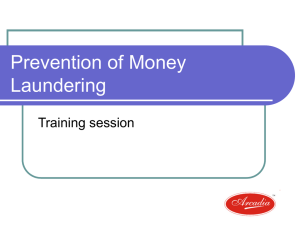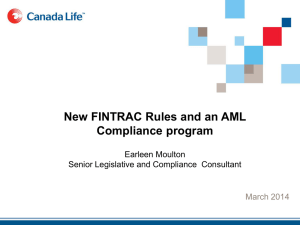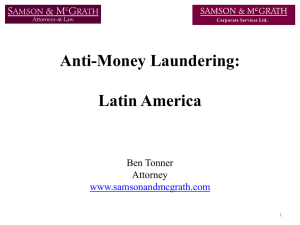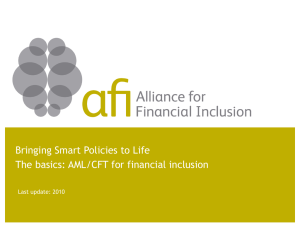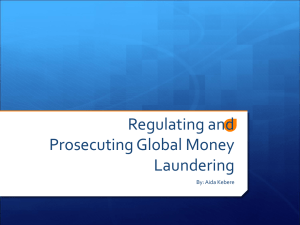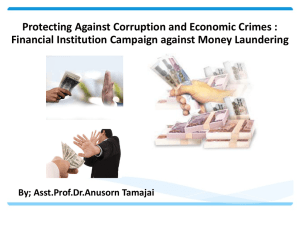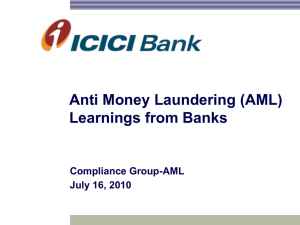Money Laundering PPT
advertisement
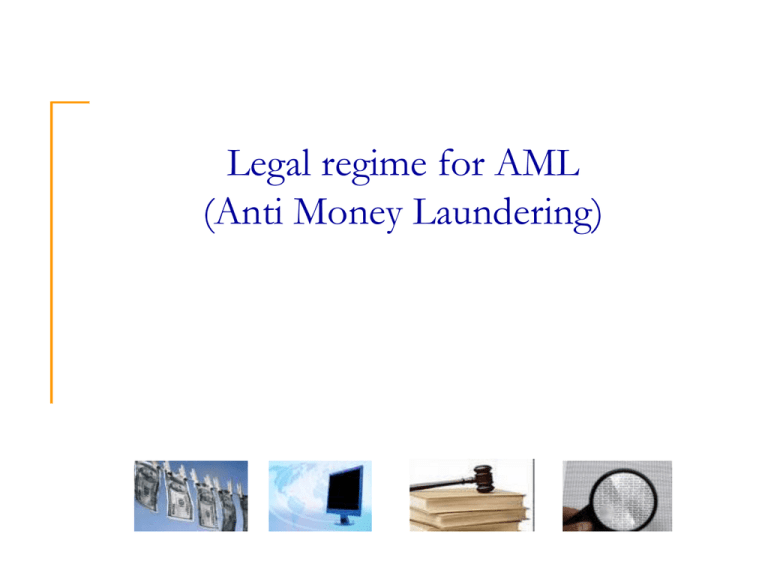
Legal regime for AML (Anti Money Laundering) Issues for Discussion Anti Money Laundering Legislation in Pakistan Implications of AML/CFT Measures on the Financial Sector International Scenario Key Issues What is Money Laundering? Money laundering is the process by which the proceeds of the crime, and the true ownership of those proceeds, are concealed or made opaque so that the proceeds appear to come from a legitimate source. Generally money laundering is the process by which one conceals the existence, illegal source, or illegal application of income to make it appear legitimate. In other words, it is the process used by criminals through which they make “dirty” money appear “clean” or the profits of criminal activities are made to appear legitimate. 3 Money Laundering (i) (ii) (iii) (iv) (v) (vi) (vii) Money laundering generally refers to ‘washing’ of the proceeds or profits generated from: Drug trafficking People smuggling Arms, antique, gold smuggling Prostitution rings Financial frauds Corruption, or Illegal sale of wild life products and other specified predicate offences 4 Money Laundering Money launderers are big time criminals who operate through international networks without disclosing their identity. The money laundered every year could be in the range of $600 bio to $2 trio. This gives money launderers enormous financial power to engage or coerce or bribe people to work for them Generally, money launderers use professionals to create legal structure/ entities which act as ‘front’ and use them for laundering of funds 5 Money Laundering Process Money Laundering consists of three stages: 1. The first stage involves the Placement of proceeds derived from illegal activities – the movement of proceeds, frequently currency, from the scene of the crime to a place, or into a form, less suspicious and more convenient for the criminal. 2. The second stage is called Layering. It involves the separation of proceeds from illegal source through the use of complex transactions designed to obscure the audit trail and hide the proceeds. The criminals frequently use shell corporations, offshore banks or countries with loose regulation and secrecy laws for this purpose. 6 Money Laundering Process 3. The third stage is called Integration. It represents the conversion of illegal proceeds into apparently legitimate business earnings through normal financial or commercial operations. Integration creates the illusion of a legitimate source for criminally derived funds and involves techniques as numerous and creative as those used by legitimate businesses. For e.g false invoices for goods exported, domestic loan against a foreign deposit, purchasing of property and comingling of money in bank accounts. 7 What is Money Laundering ? Money Laundering is the process by which illegal funds and assets are converted into legitimate funds and assets. Investments Purchases Placement: Illegal funds or assets are first brought into the financial system Layering: Use of multiple accounts, banks, intermediaries, corporations, trusts, countries to disguise the origin. Integration: Laundered funds are made available as apparently legitimate funds. Important: All money laundering transactions need not go through this three-stage process. Typologies/ Techniques employed Deposit structuring or smurfing Connected Accounts Payable Through Accounts Loan back arrangements Forex Money Changers Credit/ Debit cards Investment Banking and the Securities Sector Insurance and Personal Investment Products Companies Trading and Business Activity Correspondent Banking Lawyers, Accountants & other Intermediaries Misuse of Non-Profit Organisations 9 Financing of terrorism Money to fund terrorist activities moves through the global financial system via different typologies and in and out of personal and business accounts. It can sit in the accounts of illegitimate charities and be laundered through buying and selling securities and other commodities, or purchasing and cashing out insurance policies. Although terrorist financing is a form of money laundering, it doesn’t work the way conventional money laundering works. The money frequently starts out clean i.e. as a ‘charitable donation’ before moving to terrorist accounts. It is highly time sensitive requiring quick response. 10 Combating financing of terrorism (i) State Sponsored (ii) Other Activities- legal or non-legal Legal Sources of terrorist financing Collection of membership dues Sale of publications Cultural of social events Door to door solicitation within community Appeal to wealthy members of the community Donation of a portion of personal savings 11 Combating financing of terrorism Illegal Sources Kidnap and extortion; Smuggling; Fraud including credit card fraud; Misuse of non-profit organisations and charities fraud; Thefts and robbery; and Drug trafficking 12 Macroeconomic impact Money laundering can have a range of severe macroeconomic consequences on countries. IMF has cited unpredictable changes in money demand, prudential risks to the soundness of banking systems, contamination of legal financial transactions, and increased volatility of international capital flows and exchange rates due to unanticipated cross-border asset transfers. 13 Macroeconomic impact The economic and political influence of criminal organizations can weaken the social fabric; collective ethical standards and ultimately the democratic institutions of the society. Organized crime can infiltrate financial institutions, acquire control of large sectors of the economy through investment, or other bribes to public officials and indeed governments Money Laundering can also have a dampening effect on FDI if a country’s financial sectors are perceived to be under control and influence of organized crime. 14 Money Laundering Risks What are the risks to banks? (i) Reputational risk (ii) Legal risk (iii) Operational risk (failed internal processes, people and systems & technology) (iv) Concentration risk (either side of balance sheet) All risks are inter-related and together have the potential of causing serious threat to the survival of the bank 15 Penalties imposed on banks Jan. 2006 Aug. 2005 Feb. 2005 Jan. 2005 Oct. 2004 Sep. 2004 May. 2004 ABM AMRO US$ 80 mio Arab Bank US$ 24 mio City National Bank US$750,000 Riggs Bank US$ 41 mio AmSouth Bank US$ 50 mio City Bank Japan Licence cancelled Riggs Bank US$ 25 mio 16 What KYC means? Customer? One who maintains an account, establishes business relationship, on who’s behalf account is maintained, beneficiary of accounts maintained by intermediaries, and one who carries potential risk through one off transaction Your? Who should know? Branch manager, audit officer, monitoring officials, PO Know? What you should know? True identity and beneficial ownership of the accounts Permanent address, registered & administrative address 17 What KYC means? Making reasonable efforts to determine the true identity and beneficial ownership of accounts; Sources of funds Nature of customers’ business What constitutes reasonable account activity? Who your customer’s customer are? 18 Core elements of KYC Customer Acceptance Policy Customer Identification Procedure- Customer Profile Risk classification of accounts- risk based approach Risk Management Ongoing monitoring of account activity Reporting of cash and suspicious transactions 19 Know Your Customer (KYC) Guidelines Customer Acceptance - Ensure that only legitimate and bona fide customers are accepted. Customer Identification- Ensure that customers are properly identified to understand the risks they may pose. Transactions Monitoring- Monitor customers accounts and transactions to prevent or detect illegal activities. Risk Management- Implement processes to effectively manage the risks posed by customers trying to misuse facilities. Guidelines issued by FATF Advantages of KYC norms 1. 2. Sound KYC procedures have particular relevance to the safety and soundness of banks, in that: They help to protect banks’ reputation and the integrity of banking systems by reducing the likelyhood of banks becoming a vehicle for or a victim of financial crime and suffering consequential reputational damage; They provide an essential part of sound risk management system (basis for identifying, limiting and controlling risk exposures in assets & liabilities) 21 Risk based approach (a) (b) (c) (d) (e) The potential risk that a customer carries depends on: Identity of the customer including beneficial ownership The nature of customer’s business and his product profilejewels, precious metals, arms, antiques Location of business Products and services offered Customer’s customer or clientrs; their location & business 22 High risk countries Geography Drug producing nations Drug transshipment countries Drug using countries Secrecy jurisdictions and tax havens, particularly those that grant offshore banking licenses. Countries with high degree of public corruption Countries linked to terrorist financing Non Cooperative Countries and Territories 23 High risk customers Non-bank financial institutions ( money transmitters, cheque cashiers, full fledged money changers, sellers of stored value cards, security brokers & dealers etc. ) Travel agencies / Property dealers/ builders Professional and consulting firms Exporters or importers of goods and services Cash intensive business e.g. retail stores, restaurants, gambling casinos, second hand car dealerships etc. Off-shore corporations, banks in secrecy heavens Non-profit organisations e.g charities 24 High risk products & services Wire transfers Electronic banking services which includes services offered through internet, credit cards, stored value cards Private banking relationships Correspondent banking relationships 25 Cross border accounts-deposits All KYC procedures to be observed Third party verification of documents through Correspondent bank which is committed to KYC regime and is willing to share KYC information on demand Verification of document during visit to India Remittance through banking channels 26 Payment gateways/ wire transfers Both domestic and cross border wire transfers carry potential risk of money laundering Payment gateways facilitate wire transfers for customers of banks located anywhere in the world Whether AML/ KYC compliance level Ascertain whether it is regulated at the place of incorporation Insist on complete originator information with wire Make payment to beneficiary through account or DD Keep record of transactions 27 Salient features of IPO scam Modus operandi Current account opened in the name of multiple companies on the same date in the same branch of a bank Sole person authorised to operate all these accounts who was also a Director in all the companies Identity disguised by using different spelling for the same name in different companies Multiple accounts opened in different banks by the same group of joint account holders 28 Salient features of IPO scam Huge funds transferred from companies accounts to the individual’s account which was invested in IPO’s Loans/ overdrafts got sanctioned in multiple names to bypass limit imposed by RBI Loans sanctioned to brokers violating guidelines Multiple DP accounts opened to facilitate investment in IPO Large number of cheques for the same value issued from a single account on the same day 29 Salient features of IPO scam Multiple large value credits received by way of transfer from other banks Several accounts opened for funding the IPO on the request of brokers, some were in fictitious names Refunds received got credited in brokers a/cs Margin money provided by brokers through single cheque Nexus between merchant banker, brokers and banks suspected 30 Operational deficiencies Factors that facilitated the scam Photographs not obtained Proper introductions not obtained Signatures not taken in the presence of bank official Failure to independently verify the identity and address of all joint account holders Directors identity/ address not verified Customer Due Diligence done by a subsidiary 31 Operational Deficiencies Objective of large number of jt. account holders opening account not ascertained Purpose of relationship not clearly established Customer profiling based on risk classification not done Poor monitoring and reporting system due to inadequate appreciation of ML issues Absence of investigation about use and sources of funds 32 Operational Deficiencies Unsatisfactory training of personnel No system of fixing accountability of bank officials responsible for opening of accounts and complying with KYC procedures Ineffective monitoring and control 33 Legislative Framework Money Laundering Act, 2010 National Accountability Ordinance, 1999 Control of Narcotics Substance Act 1997 Anti-Terrorism Act 1997. National Accountability Ordinance, 1999 Deals mainly with the detection, investigation, prosecution and speedy disposal of cases involving corruption and corrupt practices The following offences under NAO covers the offence of money laundering : • • • Acquisition of any property / pecuniary advantage through corrupt, dishonest or illegal means Having assets beyond known sources of income which can not be reasonably accounted for. Pursuant to Section 20, financial institutions are bound to report suspicious financial transactions to NAB. Control of Narcotics Substance Act 1997 The following offences/ provisions under CNSA covers the AML measures: Makes the acquisition of assets through drug money an offence The suspected properties / assets may be frozen and subsequently forfeited through the Court. This measure can be construed as an anti-money laundering measure. Section 67: it is mandatory for financial institutions to report STRs to ANF, suspected to be related to drug business. Anti-Terrorism Act 1997 Deals comprehensively with the offences of terrorism and financing of terrorism. Makes compulsory for the proscribed organizations to submit all accounts for it’s political and social welfare activities and disclose all funding sources. Freezing, Seizure and Forfeiture of assets AML/CFT Measures by SBP Institutional Arrangements • Setting up of dedicated AML/ CFT Units. • Capacity Building- training Regulatory Framework Issuance of Prudential Regulations Monitoring & Enforcement On-site inspection and off-site surveillance International Obligations UNSC Resolutions- Freezing of accounts Curbing of Informal Value Transfers Formation of Exchange Companies Documentation of Economy Restriction on RTCs – Bearer Instruments AML/ CFT UNITS Primary Responsibilities of the Units • • • • Issuance of regulations and directions to banks and DFIs in accordance with FATF Recommendations and international best practices Receive STRs and process them for suitable action Coordination and liaison with relevant Govt. departments, LEAs, International and Multilateral bodies Issue directives for freezing of accounts Regulatory Framework A separate section in new PRs has been dedicated to regulations pertaining to AML and CFT. PR Compliant with 40 + 9 recommendations In line with Basel Core Principle No.15 Violations of regulations dealt with penal action International scenario International organizations engaged in AML/CFT Mid 1980s - Growing concern of international community to deprive criminal elements of the proceeds of their crimes. 1989 – Financial Action Taskforce (FATF) set up to ensure global action to combat money laundering. 1995 - Egmont Group set up to stimulate international cooperation amongst FIUs. Best Practices for exchange of information. Forty Recommendations - Complete set of counter-measures against money laundering Nine Special Recommendations on Terrorist Financing 33 members 101 Members 1997- Asia/Pacific Group on money laundering (APG) set up to create awareness and encourage adoption of AML measures. International standards – FATF 40 Recommendations + 9 Special Recommendations on TF Legal System and Related Institutional Measures R 1,2,3,26,27,28,30,32 SR II,III Preventive Measures – Financial Institutions R 4,5,6,7,8,9,10,11,13,14,15,17,18,19,21,22,23,25,29,32 SR VI, IX Preventive Measures – Non Financial Businesses and Profession R 12,16,20,24 Legal Person and arrangements & Non-profit Organizations R 33 SR VIII National and International Cooperation R 31,32,35,36,27,38,39,40 SR V FATF International standards – FATF Extension of KYC, CDD & AML/CFT measures to other sectors, as mentioned under 40+9 standards, in case of India, such as: Non-Designated Financial Businesses & Professions (NDFBPs) (R 12) : Casinos, Real estate agents, Dealers in precious metals and precious stones, Lawyers, notaries, other independent legal professionals and accountants, Trust and company service providers Exchange Houses and money remitters (R 23) Alternative remittances, Wire transfers, Non-Profit Organizations, Cash Couriers (SR VI to IX) FATF Salient Features of FATF Recommendations Criminalize ML to include all serious offences(R1) Follow standards set in Vienna & Palermo UN conventions for offence of ML(R2) Confiscate/attach laundered assets(R3) Secrecy laws should not prohibit sharing of information by financial institutions (FI)-(R4) Give special attention to business relation with countries, which do not or insufficiently apply FATF standards(R21) FIs should be subject to regulatory & supervisory measures through licensing, registrations etc. for AML purposes(R23) DNFBPs also be subject to similar regulations & supervision(R24) FATF Salient Features of FATF Recommendations FIs to follow CDD:- no anonymous accounts, verify identity of client & beneficial owner, CDD for politically exposed persons (PEP)(R5,6) CDD & Record keeping requirements for NDFBPs(R12) CDD for cross border correspondent banking(R7) Do not approve operations with Shell Banks(R18) FIs should develop AML/CFT Programme(R15): Develop internal AML/CFT policies Set screening standards while hiring employees Train employees Independent audit to test check the system Pay special attention to non face to face customers(R8) Apply similar standards to branches/offices abroad(R22) FATF Salient Features of FATF Recommendations Set up FIU, empower law enforcement agencies and competent authorities for AML/CFT(R26 to 32) Filing of STRs(R13) Provide legal immunities to financial institutions & their representatives for disclosures(R14) Maintain all necessary records(R10) Dissuasive civil/administrative/criminal sanctions for failing to comply with AML/CFT requirements(R17) International cooperation, mutual legal assistance, extradition & information exchange(R35 to 40) FATF Salient Features of FATF Recommendations Special Nine Recommendations on Terrorist Financing (TF) Ratify & implement UN instruments-SR I Criminalize TF as ML offence-SR II Freeze & confiscate terrorist assets-SR III Report STRs on TF- SR IV International cooperation on CFT- SR V KYC/CDD & AML/CFT measure for- SR VI to IX: Services involved in transmission of money/value Wire transfers Non-Profit organizations Cash couriers FATF Key Issues Key Issues To what extent should Pakistan be compliant with these 40+9 FATF recommendations? No country fully compliant These are ideal financial standards best suited for developed countries where formalization of economy is at an advanced stage Non-membership likely to have consequences How best can these standards be adopted in Pakistan? Measures to deter money laundering Board and management oversight of AML risks Appointment a senior executive as principal officer with adequate authority and resources at his command Systems and controls to identify, assess & manage the money laundering risks Make a report to the Board on the operation and effectiveness of systems and control Appropriate documentation of risk management policies, their application and risk profiles 51 Measures to deter money laundering Appropriate measures to ensure that ML risks are taken into account in daily operations, development of new financial products, establishing new business relationships and changes in the customer profile Screening of employees before hiring and of those who have access to sensitive information Appropriate quality training to staff Quick and timely reporting of suspicious transactions But it doesn't work they way we want Because ‘The law hath not been dead, though it hath slept’ 52


